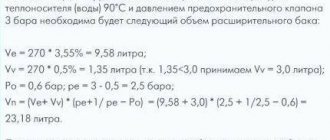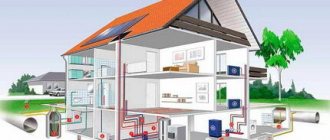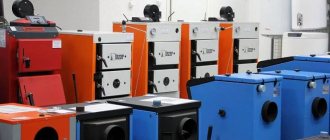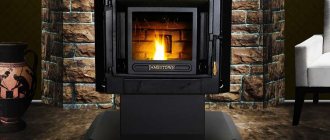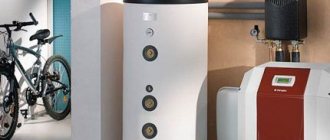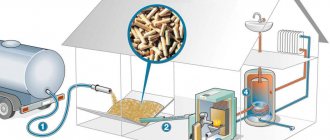Home » Insulation
Reading time 6 min Published 08/17/2019
Electric heating boilers (EHC) are autonomous heating equipment designed for heating coolant in closed (open or closed) water heating systems of apartments, houses, cottages, dachas, garages, industrial, warehouse and other premises with an area of 20 to 2400 square meters. meters without using a circulation pump.
An electric boiler is a direct-acting installation (without the use of intermediate components). Heating of the liquid occurs due to the flow of electric current through the coolant.
The heating effect occurs due to the disordered movement of coolant fluid ions from the cathode to the anode with a frequency of 50 vibrations per second (hence the second name for electric boilers - ion boilers).
The chaotic movement of ions leads to the fastest possible increase in coolant temperature.
The use of electric heating boilers is also possible in parallel with other boilers: solid fuel or gas; installation in parallel with a gas boiler is convenient in the absence of gas. Here are some benefits:
- EOU efficiency is 96-98% when used in a heating system of two boilers
- equipped with an automatic heating temperature control sensor
- has small dimensions
- The coolant is heated in a matter of minutes by its full volume
- does not require additional approval for installation and operation from boiler inspection authorities
Layering of solid deposits (scale) on the electrodes and walls of the boiler does not lead to the destruction of the electrodes themselves or the unit as a whole, but only weakens its power. A switched on ion boiler in the “dry running” stage (no coolant (liquid) in the boiler) is absolutely safe; there is no heating of water, and the device will not fail.
Oxidation-reduction processes are not observed due to the frequent interchange of electrodes (anode with cathode). Ion boilers have another indisputable advantage in comparison with their “competitors” - they do not require re-equipment of the existing heating system of the home, but are easily installed into an already working system.
Check out some of the characteristics of the EOU:
- One kilowatt of EOU power heats 60 cubic meters. m. (20 sq. m.)
- The duration of operation of the EOU in a water heating system is from 1 to 8 hours a day, depending on the ambient temperature (automatic operating mode with a temperature sensor-relay), therefore, when heating an area from 40 to 750 sq. m. electricity consumption per day ranges from 2 to 288 kW/h (depending on the modification, see the characteristics table)
- During operation in a water heating system, the EOU lifts the heated coolant to a height of 3 to 24 meters (depending on the modification), due to the large temperature difference at the inlet and outlet of the electrical installation, which allows heating single-story and multi-story rooms without the use of circulation pumps
- EOU is suitable for different types of water heating systems
- The inlet and outlet of the EOU is installed in the water heating system through plumbing couplings, plumbing adapters or plumbing hoses. The input of the EOU is mounted in the return line, and the output in the supply line of the water heating system
- In a water heating system in which a boiler (boilers) is already installed, the EOU is mounted parallel to this boiler (boilers)
- In a forced circulation water heating system, the circulation pump is installed in the return line of the water heating system in front of the electrical installation.
- All work on installing an electrical installation in a water heating system is carried out in the same way as with conventional electric boilers, gas boilers, furnaces, etc.
- Electrical installation outlet temperature: up to 95 °C
- Working medium (coolant): water and antifreeze liquids for water heating systems
- Operating voltage: 220/380V±10%
- Length (single-phase version): 300 mm
- Connecting dimensions: inlet G1″, outlet G1¼″
- Length (three-phase modification): 400 mm
- Connecting dimensions: inlet G1¼″, outlet G1¼″
Advantages and disadvantages of EOU
By installing an energy-saving electric heating boiler in your home, you can achieve a significant reduction in energy costs. Unlike conventional heating elements models, they heat up the coolant faster, accelerating the heating of buildings and reducing idle consumption, which is typical for heating elements with their high inertia. Let's see what advantages energy-saving heating systems have:
As you can see from the picture, the device of the electrode boiler is very simple and there is practically nothing to break here.
- An extremely simple design - there is practically nothing to break here, while classic heating elements constantly fail and burn out;
- Increased fire safety - even if the coolant disappears somewhere, the energy-saving boiler will simply interrupt its operation;
- Instant start - the coolant begins to heat up immediately after switching on. Thanks to this, energy savings and rapid heating of rooms are achieved;
- Long service life of the entire system - if it does not use aggressive salt additives;
- Lack of scale – typical for both induction and ion (electrode) boilers;
- Easy connection - no permits or other documents required.
Energy-saving installations also have certain disadvantages:
- Despite their reduced energy consumption, they cannot compete with gas boilers;
- The need for powerful electrical wiring and a separate line (for boilers with a power of over 3 kW);
- Gradual damage to the entire heating system when using aggressive coolants.
Despite this, electric energy-saving heating boilers remain in demand heating equipment.
When using energy-saving boilers, you cannot count on reducing costs tenfold - the maximum savings are up to 20-30% when compared with the costs of operating conventional heating element boilers.
Operating principle and device
Electrode boiler device
Electrode boilers for heating a private house operate according to the standard laws of physics. The liquid in the unit is heated not with the help of any element, but with the help of the molecular decomposition of water into differently charged ions. Two electrodes are installed in a container with coolant, and the supply of electricity is started. Water molecules under the influence of a current with a frequency of 50 Hertz (the number of vibrations per minute) are divided into positively charged and negatively charged ions. At the moment of the separation process, heat is produced. Each ion is drawn with its charge to a specific electrode.
Heating of water is very fast, since the resistance of the coolant is high and the electrolysis process prevents the appearance of scale on the walls of the boiler. We can conclude that an electric electrode boiler is an ever-functioning device.
The design of such a boiler is not complicated. This is a unit of small dimensions in the form of a pipe, which constantly cuts into the pipe junction system by means of a threaded connection using American ones. In addition, the electrodes are connected at one end of the device. The coolant fluid is launched through the side pipe, and the exit is through the unoccupied end.
How to connect an electric heating boiler?
By connecting a powerful electric boiler to a two-phase grid, there is a risk of leaving without light not only the power supply system of your private home, but also the entire area.
Safety It consists of three components: Reliable automatic shutdown.
Diagram of a heating system with two solid fuel and electric boilers, a heat accumulator, hot water supply and two heating circuits - radiator and in-floor. Installing protective equipment When all the input wires are connected to the electric boiler, it will be necessary to additionally protect it with a circuit breaker and an RCD installed in the main panel. Moreover, if a malfunction is detected, you can always take advantage of the repair guarantee.
Of course, this is a general rule; in real conditions, when choosing the power of a boiler, many factors are taken into account, but in general, the rule reflects the approximate, average requirements for the boiler correctly. A hydraulic comb is a necessary and important component for a water heated floor.
This was due to many factors. Wiring Sources of heating of wiring can be: Wire with a reduced cross-section; Detachable connections for sockets, terminals, etc. Expansion membrane tank.
Water is heated at night, stored warm and used during the day, energy consumption during the day is reduced, as well as electricity bills. Today I want to answer these questions in detail and as clearly as possible and tell you which electric boiler connection diagram will allow you to heat your home at minimal cost. When the boiler is operating at full power, it should not heat up: high temperatures can damage the insulation.
Where to begin
Correspondence table for the wiring cross-section of the power of a three-phase boiler. Make ventilation. All devices must be grounded, i.e.
Heating of the circulating coolant is carried out through the interaction of the liquid with thermoelectric heating elements in the chamber of the device. The electrical circuit must prevent electric shock to the user and ensure that the power is turned off in the event of a short circuit; Correct wiring calculation. If electric heating is planned to be organized for a building with a large area, then when purchasing equipment you need to choose one that provides the possibility of installing a cascade. How to connect two boilers to one heating system. House heating diagram
How to choose?
Many people wonder how to choose a good electric heating boiler for heating. One of the most important properties for this type of equipment is the efficiency indicator, which has already been mentioned. The efficiency of such devices and operating costs depend on it. But in the case of the equipment under consideration, this coefficient is not so important due to the fact that all models have an efficiency of around 96–98 percent
Therefore, you should pay attention to other characteristics
The most important is power. It is usually measured in kilowatts
It determines how much heat transferred to the liquid will enter the heating mechanism. The power of boilers is usually provided by the operation of electric heating elements, which are located inside the heat exchanger.
For electric boilers, this characteristic ranges from two to sixty kilowatts. In order to correctly select the power of the electric boiler, a thermal engineering calculation should be made for the entire building. It is best if specialists do this. This characteristic should be determined at the rate of 1 kilowatt per 10 square meters of room area. If you still need to heat the water, then the power should be at least a quarter more.
Another important characteristic is the control mechanism. With its help you can significantly reduce heating and hot water costs. Different models of thermal generators offer different options for reducing energy consumption. Typically, automatic control mechanisms are used, which are responsible for regulating the operation of units. The simplest such device is a thermostat. The essence of its operation is extremely simple - you need to set the desired temperature of the coolant at the outlet, when it increases to the required value, the thermostat turns off the heating elements.
Another important factor that you should pay attention to when selecting an electric boiler is its configuration. This point affects both the price of the unit and the efficiency
It was mentioned above that purchasing models with incomplete components entails additional financial costs for the purchase of parts and time losses for installation. If we talk about the complete set of electric boilers, then a number of models are miniature boiler rooms. They have a circulation pump, an expansion tank, remote-type temperature sensors, a filter that is responsible for purifying the coolant, an anti-freeze mechanism, and others.
The criterion that you should pay attention to when selecting an electric boiler is the voltage of the electrical network. Although this factor does not apply to the devices themselves, it cannot be ignored
Powerful boilers require 380 volt line voltage. For this reason, before purchasing a boiler, you should find out whether such a line can be drawn to the desired object. If not, then it is better to be content with a single-phase 220 volt solution. Naturally, not the last point, in addition to the indicated properties, when selecting an electric boiler is its manufacturer.
How to make an electrode boiler with your own hands
The main skill you will need is the ability to operate a cooker. The main parts for the design are a metal tube and an electrode.
Let's get started. To make an electrode boiler with your own hands, you will need the following elements:
- Welding machine.
- Pipe with a diameter of up to 10 cm and a length of no more than 25 cm.
- Electrode (you can take a small metal rod with a diameter of about 11 mm).
- The appropriate size tee.
- Coupling.
- Insulator for electrode and terminals (grounding, neutral).
Let's start the assembly process:
- At the first stage, you need to screw on the coupling with a tee on both sides and tighten the products firmly to prevent leaks.
- At the second stage, you need to immerse the electrode from the tee side into the pipe, firmly installing it inside using a dielectric insulator. You can use a plug from a bimetallic radiator. The goal is to create space between the pipe and the electrode. All you need to do in the plug is make a hole of the required diameter, insert a rod there and secure it firmly with a nut from the outside.
- The next step is to weld a pair of bolts on the pipe body (M8 or M10). They are necessary to connect the zero terminal and the ground terminal. Exposed connection points must also be protected to limit yourself from electric shock.
- The fourth stage will be the installation of the boiler and its piping. The dimensions of the structure are not large, so it can be hidden under the sink.
- All. You can run coolant for electrode heating boilers and test the heating system.
Popular models
A wide range of energy-saving electric boilers are available for sale, so finding the optimal solution will not be difficult
When choosing a budget solution, it is recommended to pay attention to the Galan-Ochag 3 model, which is produced by the Russian
Boiler Galan Hearth 3 Photo source: subscribe.ru
The device features support for three power levels, and uninterrupted operation is possible both when connected to a three-phase network and to a single-phase one.
From customer reviews, the system has low power (up to 6 kW), but this is justified by the economical consumption of energy resources. The optimal scope of application is utility rooms and country buildings with an area of no more than 30-35 square meters. m. The maximum permissible coolant volume is 70 liters.
The advantages of "Ochag 3" include ease of installation, lack of mandatory maintenance and affordable cost - no more than 4 thousand rubles. The downside is the limited scope of operation due to limited power.
A popular boiler model is KOSPEL EKCO.LN, which comes with an expansion tank. They belong to the group of energy-saving units due to the presence of a 6-step performance adjustment, which is selected automatically. The power is 6 kW, and the efficiency is 99%. The installation will be effective in a room with an area of up to 60 square meters. m.
Boiler KOSPEL EKCO.LN Photo source: stroyaqua.com
EOUs from the SAV company operate on the induction principle and are produced in Russia. Their price segment varies from 30 to 150 thousand rubles, but this is justified by high power and efficiency indicators (up to 99%).
The company's product range includes ready-made units for private purposes with a power of up to 7 kW and powerful industrial units with a power of up to 500 kW.
The Prof SAV-5 model deserves special attention. Being a popular floor-standing boiler with a single-phase induction operating principle, this system has been a leader in the sales lists for more than 3 years. The device includes a metal cylinder that weighs 27 kg, has a height of 45 cm and a diameter of 12 cm.
Photo source: climl.ru
Antifreeze acts as a coolant. When pouring the substance yourself, you need to wear protective clothing and gloves. The advantages of SAV equipment include fast heating, small dimensions and economical consumption of electrical energy.
However, the cost of antifreeze is quite high, and its shelf life does not exceed 3 years. The system is also afraid of power surges and needs to install a stabilizer.
When choosing a boiler for heating a private home, you need to take into account its distinctive properties and advantages. You should also familiarize yourself with the following indicators:
Performance
At the selection stage, you should pay attention to the efficiency values. Installations that support intelligent energy saving automation operate based on temperature fluctuations in the room
The possibility of uncontrolled inertia is eliminated. The device provides the thermal potential required for effective heating of the building. Most models demonstrate high levels of efficiency up to 97-98%. Appearance. When faced with the problem of choosing a boiler, make sure that it will correspond to the interior style concept and fit harmoniously into the room. Modern installations are quite ergonomic and attractive. Set of functions. It is recommended to choose units that support the option of instant heating of the coolant. It determines the efficiency of operation and contributes to faster heating of the building. The functionality of the system is determined by its model and cost. Availability of a warranty card. If the manufacturer provides a warranty document, this is the best proof that the device is of high quality and reliable. The declared service life exceeds 30 years. Even in the event of an unexpected failure or damage, you can have the boiler repaired free of charge at the service center. Reviews. At the selection stage, you need to read reviews about the manufacturer and model of heating equipment you are interested in.
Using the tips listed above, you can choose a high-quality boiler that will serve its owner for many years.
Advantages and disadvantages
If we consider the advantages of electric boilers, the following should be mentioned:
- the use of such equipment is not associated with combustion or open fire; according to fire safety criteria, such boilers are the most reliable, of course, if the electrical wiring is in order and good fuses are installed;
- absence of combustion products - the possibility of poisoning by combustion products or carbon monoxide is completely excluded, so there is no need to equip a combustion product removal system, or additional ventilation;
- this type of boiler does not require a separate boiler room; it can be installed anywhere due to the fact that the operation of the device does not involve the release of various gases and even unpleasant odors; Now such boilers have a pleasant appearance and can become a wonderful piece of furniture in the same utility room, kitchen or hallway;
- such boilers are considered environmentally friendly;
- they are very easy to operate and maintain;
- It is very easy to prepare documentation for them;
- the installation procedure for such a boiler is extremely simple and can be carried out even by a non-specialist;
- the models under consideration have the highest efficiency, which is 98–99 percent;
- when installing such a boiler, there is no need to register it and contact regulatory authorities;
- light weight and compact dimensions of modern models;
- Such units are an excellent component for a “smart home” mechanism.
At first glance, electric boilers seem to be almost an ideal source for heating a room.
They, like any other devices, have a number of quite significant disadvantages.
- High cost of electrical energy. Before purchasing such a boiler, you should consider whether its use is beneficial from an economic point of view, because the goal is to save money and not spend even more than before.
- In this case, an open heating system cannot be used. The same applies to the option with natural circulation of the coolant.
- Not all types of batteries can be used. Some battery models cannot be used in a heating system where the central element is an electric boiler. We are talking about heavy cast iron batteries, as well as steel radiators. They will simply cause unnecessary losses of electrical energy, and their operating efficiency will be extremely low. The best solutions are bimetallic models.
- A number of electric boilers are very sensitive to the chemical composition and quality of the coolant used.
- Such a heating system is completely dependent on the supply of electrical energy. If there are power outages in the city, then it is better not to install such equipment.
- For high-quality work, the installation of a voltage stabilizer is required, which entails additional costs.
In general, there are arguments both for and against such a heating boiler. If we look at the reviews about the use of such heating solutions, they are mostly positive. Users note the cost-effectiveness and high efficiency of such boilers. They also include good, quick heating of the room among its advantages. This allows you to create a high-quality climate inside and significantly increase the comfort of your stay.
If we talk about the disadvantages, users note the high cost of electrical energy, as well as certain limitations in terms of the inability to use various types of radiators. From certain points of view, today electric boilers are one of the best solutions on the market. Properly planned and installed pipe distribution, as well as correctly placed batteries in various rooms in combination with an electric boiler, allow for optimal and uniform transport of heat to various rooms of the house. This makes it possible to regulate the heating temperature well, which allows you to truly make the microclimate in the house ideal for all family members, as well as save energy resources.
Design features
A distinctive feature of all heating boilers is the heating element. Depending on its type, units are classified as follows:
- electrode;
- using heating elements;
- induction
Heating equipment is also distinguished by the type of heat exchanger design. This design can be a built-in boiler or a flow-through system. Let's look at each category of boilers separately.
Electrode heating equipment
Heating is carried out by passing an electric current through the liquid. Electrodes can only be used if the coolant is water. Its heating occurs due to its own resistance, which occurs when the electrode emits a charge.
Equipment based on this heating element is the safest for the home, because if there is a water leak, it turns off. The device reacts in the same way when there is a short circuit or the temperature rises above normal.
Devices with heating elements
The principle of operation is to heat running water using special elements - heating elements. Advantages of this type:
- high degree of reliability;
- compact overall dimensions;
- automated management process;
- natural circulation.
Such design features allow you to install the unit on the wall, and the automated system allows you to maintain the required temperature in the house. By turning off and on the required number of heating elements, you can regulate the electricity consumption.
The disadvantage of this type of dual-circuit devices is the formation of scale. It increases power consumption by reducing heat transfer. But the advantages outweigh the disadvantages and make such units the most popular. They are easy to use and have low cost.
Induction equipment
Heating is carried out by an inductor made of ferromagnetic alloys. It is located in a separate compartment and does not come into contact with the coolant. The water circulating around the perimeter is subjected to induction heating.
Compared to the options discussed above, this type of heating equipment has a higher cost and is also larger in size. These indicators are the main disadvantages, but there are also significant advantages:
- leaks and breakdowns are excluded;
- minimal scale formation;
- safety of operation.
Boilers with built-in boiler
Their installation is relevant when there is a need for constant access to hot water in the house. They have the following features:
- in the absence of electrical power, there is always a supply of hot water available;
- there is no need for regular cleaning of the boiler;
- hot water volume up to 60 liters.
Flow system
Installation is advisable in cases where daily water consumption does not exceed 10-15 liters. The maximum temperature in such a system does not exceed 30C°, and the temperature of the water in it depends on the speed of its flow through the heat exchanger.
Giving preference to a double-circuit design, you can opt for any type. But an important role is played by indicators on which the cost of heating will depend after.
Characteristic
An electrode boiler (also called an ion or ion exchange boiler) differs from other units operating from the network in that it has an open electrode to which current is supplied.
Refers to direct heating heating devices in which heat is directed directly to the energy carrier. This makes it possible to instantly increase the power of the structure, because there are no obstacles in the heat transfer process.
Heating is carried out using electrodes that are immersed in a tank of liquid. Current is conducted through the coolant with a frequency of 50 Hertz and creates a barrier to electrolysis. Therefore, the inside of the boiler remains free of scale deposits.
The heating process of the liquid occurs with the help of resistance that appears. This happens very quickly. Thus, the container (tank) may not be large in size, since it is not necessary to wait for the liquid to be heated by the element. Such design properties of this boiler allow you to save the user’s budget by reducing energy consumption in the heating system.
An electrode heating boiler is very sensitive to the composition of water; ordinary tap water cannot be used to operate the unit.
Before installation, special preparation of the liquid is required. It’s good if there are antifreezes available that are recommended by the manufacturer.
Antifreeze for the heating system can be made based on ethylene glycol and propylene glycol. More details at.
It also has another feature, which is the gradual dissolution of the electrodes. This is a natural process, its acceleration and deceleration depends only on the intensity of use of the heating system.




